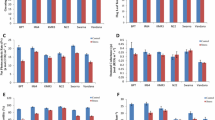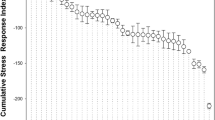Abstract
The grain filling of rice is gets weakened by heat stress due to reduced spike photosynthesis at high temperature stress. An alternate source of carbon is stored stem reserves for grain filling. Rate of stem dry matter, translocation efficiency (TE) and contribution rate (CR), grain yield were monitored under control and high temperatures in the growth chamber. Cultivar Nagina 22 (N22) always sustained higher grain filling rate (GFR), TE and CR percentage as well as grain yield than Coimbatore 51 (CO51). Hypothesis of Translocation efficiency was evaluated under field condition since it acts as an important source of carbon for supporting grain filling rate under heat stress. Low sterility genotypes had a higher GFR and TE percentage at the onset of grain filling, greater depletion of stem dry matter and longer duration of grain filling than high sterility genotypes. On the other hand, high sterility genotypes were more heat-susceptible than low sterility genotypes in terms of higher spikelet sterility, higher panicle temperatures and lower GFR and reduced TE percentage at elevated temperature. This suggests that detailed physiological studies under controlled-environment conditions where compared to the performance under field conditions. Therefore, the superior capacity of low sterility genotypes including N22 for grain filling from mobilized stem reserves is a constitutive trait which supports grain filling under heat stress that improves grain filling rate and grain yield in rice.



Similar content being viewed by others
References
Ali F, Waters DLE, Ovenden B, Bundock P, Raymond CA, Rose TJ (2019a) Australian rice varieties vary in grain yield response to heat stress during reproductive and grain filling stages. J Agron Crop Sci 205:179–187
Ali F, Waters LE, Ovenden B, Bundock P, Raymond CA, Rose TJ (2019b) Heat stress during grain fill reduces head rice yield through genotype dependant increased husk biomass and grain breakage. J Cereal Sci 90:1–7
Alvaro F, Royo C, García del Moral LF, Villegas D (2008) Grain filling and dry matter translocation responses to source-sink modifications in a historical series of durum wheat. Crop Sci 48:1523–1531
Arshad MS, Farooq M, Asch F, Jagadish SVK, Prasad PV, Siddique HM (2017) Thermal stress impacts reproductive development and grain yield in rice. Plant Physiol Biochem 115:57–72
Blum AB, Sinmena A, Mayer J, Golan J, Shpiler L (1994) Stem reserve mobilisation supports wheat-grain filling under heat stress. Aust J Plant Physiol 21:771–781
Chaturvedi AK, Bahuguna RN, Shah D, Pal M, Jagadish SVK (2017) High temperature stress during flowering and grain filling offsets beneficial impact of elevated CO2 on assimilate partitioning and sink strength in rice. Sci Rep 7:1–13
Cheabu S, Moung-Ngam P, Arikit S, Vanavichit A, Malumpong C (2018) Effects of heat stress at vegetative and reproductive stages on spikelet fertility. Rice Sci 25(4):218–226
Dias AS, Lidon FC (2009) Evaluation of grain filling rate and duration in bread and durum wheat, under high temperature stress after anthesis. J Agron Crop Sci 195(2):137–147
Edreira JIR, Otegui ME (2012) Heat stress in temperate and tropical maize hybrids differences in crop growth, biomass partitioning and reserves use. Field Crops Res 130:87–98
Edreira JIR, Carpici EB, Sammarro D, Otegui ME (2011) Heat stress effects around flowering on kernel set of temperate and tropical maize hybrids. Field Crops Res 123:62–73
Esten Mason R, Mondal S, Beecher F, Hays D (2011) Genetic loci linking improved heat tolerance in wheat (Triticum aestivum L.) to lower leaf and spike temperatures under controlled conditions. Euphytica 180:181–194
Farooq M, Nadeem F, Gogoi N, Ullah A, Alghamdi SS, Nayyar H (2017) Heat stress in grain legumes during reproductive and grain-filling phases. Crop Pasture Sci 68:985–1005
Huang M, Fang S, Cao F, Chen J, Shan S, Liu Y (2020) Prolonging seedling age does not reduce grain yields in machine-transplanted early-season rice under precision sowing. Ann Appl Biol 176:308–313
Iqbal M, Raja NI, Yasmeen F, Hussain M, Ejaz M, Shah MA (2017) Impacts of heat stress on wheat: a critical review. Adv Crop Sci Tech 5:1–9
Ishimaru T, Horigane AK, Ida M, Iwasawa N, San-oh YA, Nakazono M (2009) Formation of grain chalkiness and changes in water distribution in developing rice caryopses grown under high-temperature stress. J Cereal Sci 50:166–174
Islam MR, Feng B, Chen T, Fu W, Zhang C, Tao L, Fu G (2018) Abscisic acid prevents pollen abortion under high temperature stress by mediating sugar metabolism in rice spikelets. Physiol Plant. https://doi.org/10.1111/ppl.12759
Julia C, Dingkuhn M (2013) Predicting temperature induced sterility of rice spikelets requires simulation of crop-generated microclimate. Eur J Agron 49:50–60
Kim J, Shon J, Lee CK, Yang W, Yoon Y, Yang WH, Kim YG, Lee BW (2011) Relationship between grain filling duration and leaf senescence of temperate rice under high temperature. Field Crops Res 122:207–213
Li G, Pan J, Cui K, Yuan M, Hu Q, Wang W, Mohapatra PK, Nie L, Huang J, Peng S (2017) Limitation of unloading in the developing grains is a possible cause responsible for low stem non-structural carbohydrate, translocation and poor grain yield formation in rice through verification of recombinant inbred lines. Front Plant Sci 8:1–16
Madan P, Jagadish SVK, Craufurd PQ, Fitzgerald M, Lafarge T, Wheeler TR (2012) Effect of elevated CO2 and high temperature on seed-set and grain quality of rice. J Exp Bot 63:3843–3852
Madani A, Shirani Rad A, Pazoki A, Nourmohammadi G, Zarghami R (2010) Wheat (Triticum aestivum L.) grain filling and dry matter partitioning responses to source: sink modifications under post anthesis water and nitrogen deficiency. Acta Sci Agronom 32:145–151
Mahajan G, Chauhan BS (2016) Performance of dry direct-seeded rice in response to genotype and seeding rate. Agron J 108:257–265
Miyazaki M, Araki M, Okamura K, Ishibashi Y, Yuasa T, Iwaya-Inoue M (2013) Assimilate translocation and expression of sucrose transporter, OsSUT1, contribute to high-performance ripening under heat stress in the heat-tolerant rice cultivar. J Plant Physiol 170:1579–1584
Mohammed AR, Tarpley L (2010) Effects of high night temperature and spikelet position on yield-related parameters of rice (Oryza sativa L.) plants. Eur J Agron 33(2):117–123
Moura DS, Brito GG, Campos AD, Moraes IT, Porto F, Teixeira SB, Fagundes F, Andres A, Schreiber F, Deuner S (2017) Non-structural carbohydrates accumulation in contrasting rice genotypes subjected to high night temperatures. J Agric Sci 9(12):1–14
Pal R, Mahajana G, Sardanaa V, Chauhan BS (2017) Impact of sowing date on yield, dry matter and nitrogen accumulation and nitrogen translocation in dry-seeded rice in North-West India. Field Crops Res 206:138–148
Paul T, Edwards J, Bennett D, Ganesalingam D, Able J, Kuchel H (2018) A field and controlled environment evaluation of wheat (Triticum aestivum) adaptation to heat stress. Field Crops Res 229:55–65
Paul P, Dhatt BK, Sandhu J, Hussain W, Irvin L, Morota G, Staswick P, Walia H (2020) Divergent phenotypic response of rice accessions to transient heat stress during early seed development. Plant Direct 4:1–13
Prasad PVV, Bheemanahalli R, Jagdish SK (2017) Field crops and the fear of heat stress-opportunities, challenges and future directions. Field Crops Res 200:114–121
Reynolds M, Langridge P (2016) Physiological breeding. Curr Opin Plant Biol 31:162–171
Sailaja B, Subrahmanyam D, Neelamraju S, Vishnukiran T, Venkateswara Rao Y, Vijayalakshmi P, Voleti SR, Bhadana VP, Mangrauthia SK (2015) Integrated physiological, biochemical and molecular analysis identifies important traits and mechanisms associated with differential response of rice genotypes to elevated temperature. Front Plant Sci 6:1–13
Sánchez B, Rasmussen A, Porter JR (2014) Temperatures and the growth and development of maize and rice: a review. Glob Change Biol 20:408–417
Sathishraj R, Bheemanahalli R, Ramachandran M, Dingkuhn M, Raveendran M, Jagadish SVK (2016) Capturing heat stress induced variability in spikelet sterility using panicle, leaf and air temperature under field conditions. Field Crops Res 190:10–17
Sehgal A, Sita K, Siddique K, Kumar R, Sailaja B, Varshney RK, HanumanthaRao B, Nair RM, Prasad PVV, Nayyar H (2018) Drought or/and heat-stress effects on seed filling in food crops: impacts on functional biochemistry, seed yields, and nutritional quality. Front Plant Sci 9:1–19
Shi W, Muthurajan R, Rahman H, Selvam J, Peng S, Zou Y, Jagadish SVK (2013) Source-sink dynamics and proteomic reprogramming under elevated night temperature and their impact on rice yield and grain quality. New Phytol 197:825–837
Shi P, Zhu Y, Tang L, Chen J, Sun T, Cao W, Tian Y (2016) Differential effects of temperature and duration of heat stress during anthesis and grain filling stages in rice. Environ Exp Bot 132:28–41
Sofield I, Evans LT, Cook MG (2019) Factors influencing the rate and duration of grain filling in wheat. Aust J Plant Physiol 4:785–797
Sruthi N (2018) Effects of high temperature stress and traits associated with tolerance in wheat. J His Arch Anthropol Sci 3:177–186
Streck NA (2005) Climate change and agroecosystems: the effect of elevated atmospheric CO2 and temperature on crop growth, development and yield. Ciencia Rural 35:730–740
Tanamachi K, Miyazaki M, Matsuo K, Suriyasak C, Tamada A, Matsuyama K (2016) Differential responses to high temperature during maturation in heat-stress tolerant cultivars of Japonica rice. Plant Prod Sci 19:300–308
Vivitha P, Raveendran M, Vijayalakshmi D (2017) Introgression of QTLs controlling spikelet fertility maintains membrane integrity and grain yield in improved white Ponni derived progenies exposed to heat stress. Rice Sci 24(1):32–40
Wang Y, Oue H, Luo Z, Chen M, Liu S, Zhou C, He X (2020) Estimating rice panicle temperature with three-layer model. Adv Meteorol 2020(22):1–13
Wu C, Cui K, Hu Q, Wang W, Nie L, Huang J, Peng S (2019) Enclosed stigma contributes to higher spikelet fertility for rice (Oryza sativa L.) subjected to heat stress. Crop J 7(3):335–349
Yang J, Zhang J, Wang Z, Zhu Q, Liu L (2001) Water deficit–induced senescence and its relationship to the remobilization of pre-stored carbon in wheat during grain filling. Agron J 93:196–206
Zafar SA, Hameed A, Salam Khan A, Ashraf M (2017) Heat shock induced morpho-physiological response in indica rice (Oryza Sativa L) at early seedling stage. Pak J Bot 49(2):453–463
Zandalinas SI, Mittler R, Balfagón D, Arbona V, Gómez-Cadenas A (2018) Plant adaptations to the combination of drought and high temperatures. Physiol Plant 162:2–12
Zhang CX, Fu GF, Yang XQ, Yang YJ, Zhao X, Chen TT, Tao LX (2016) Heat stress effects are stronger on spikelets than on flag leaves in rice due to differences in dissipation capacity. J Agron Crop Sci 202:394–408
Zhang CX, Feng BH, Chen TT, Fu WM, Li HB, Li GY, Jin QY, Tao LX, Fu GF (2018) Heat stress-reduced kernel weight in rice at anthesis is associated with impaired source-sink relationship and sugars allocation. Environ Exp Bot 155:718–733
Zhao C, Liu B, Piao S, Wang X, Lobell DB, Huang Y (2017) Temperature increase reduces global yields of major crops in four independent estimates. Proc Natl Acad Sci 114:9326–9331
Acknowledgements
The authors acknowledge National Institute for Agro Environmental Sciences (NIAES, Japan) for providing the Infra-red radiometers and cameras from the collaborative MINCERnet research project.
Author information
Authors and Affiliations
Corresponding author
Ethics declarations
Conflict of interest
There is no conflict of interest.
Additional information
Publisher's Note
Springer Nature remains neutral with regard to jurisdictional claims in published maps and institutional affiliations.
Rights and permissions
About this article
Cite this article
Ayyavu, V., Dhashnamurthi, V. & Venugopal, B.R.P. Controlled-environment and field evaluation of heat stress induced genetic variability on translocation efficiency and grain filling traits in rice. J. Crop Sci. Biotechnol. 25, 535–545 (2022). https://doi.org/10.1007/s12892-022-00149-1
Accepted:
Published:
Issue Date:
DOI: https://doi.org/10.1007/s12892-022-00149-1




